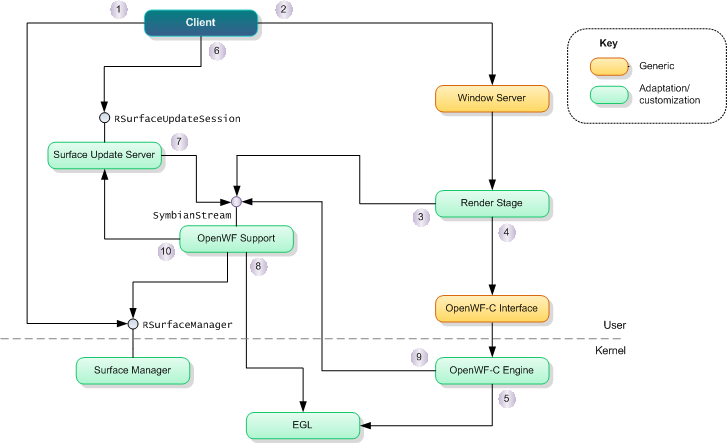OpenWF Support Component Overview
The OpenWF Support component provides a Symbian-specific implementation of platform-specific elements of the OpenWF-C specification and abstracts communication between the OpenWF-C Engine and other Symbian graphics components.
Target audience: Device creators.
Purpose
The OpenWF Support component has two main roles:
It provides an implementation of OpenWF-C native stream.
OpenWF-C represents external content as native stream sources and targets. Within OpenWF-C, native streams are an adaptation feature. The OpenWF-C native stream is based on an opaque handle (WFCNativeStreamType) and an API consisting of a number of methods and properties on that handle. This allows the internal details of content presented to OpenWF-C for composition to be mapped to the operating environment.
The Symbian Surface Manager and Surface Update Server components represent external content as composition surfaces, which are identified by the surface ID (TSurfaceId). The Symbian OpenWF Support component provides an implementation of native stream, called SymbianStream, in terms of composition surfaces.
The Symbian stream API is based on exported C functions in order to simplify integration with OpenWF-C implementations. Most of the functions create, or take as a parameter, a handle to a native stream, typedef SymbianStreamType.
The API is intended to operate in the caller’s thread, but is multi-threading-safe. However, many of the operations perform memory allocation and therefore require that the client threads present a consistent default heap. This restriction has performance benefits and does not add an overhead to production use-cases. However, it complicates test scenarios.
Calling threads must have the Cleanup Stack enabled.
It repackages the Surface Update Server API for use by OpenWF-C implementations.
The OpenWF Support component interfaces with the Surface Update Server using a C++ update proxy class that implements the MCompositionSurfaceUpdate interface, which is specified by the Surface Update Server component.
The native stream implementation supports the Surface Update Server API and re-packages it for use by OpenWF-C engines.
Registration with the Surface Update Server is initiated by the OpenWF Support C API method SymbianStreamRegisterScreenNotifications(), which calls MSurfaceUpdateServerProvider::Register().
Architectural relationships
The following diagram provides a simplified view of key relationships between the OpenWF Support component and other key graphics components.
The numbers in the diagram show the approximate sequence when a rendering client creates a surface and renders into it. This assumes that the OpenWF-C context has registered the screen with the Surface Update Server during construction.
The client application calls RSurfaceManager::CreateSurface() to create the surface to render into.
The client application calls RWindowBase::SetBackgroundSurface() to attach the surface to a window.
The render stage casts the address of the TSurfaceId object to the OpenWF-C native stream (WFCNativeStreamType).
The render stage calls the OpenWF-C wfcCreateSourceFromStream() function to create a source from the native stream.
The OpenWF-C engine creates an EGL sync object.
The client application renders content to the surface and calls RSurfaceUpdateSession::SubmitUpdate().
The Surface Update Server calls MCompositionSurfaceUpdate::ContentUpdated() on the proxy class. This signals the native stream that the content has been updated.
The OpenWF-C Support component signals the EGL sync object.
The OpenWF-C engine acquires the buffer and composes its content and then releases the buffer.
The OpenWF-C Support component composes notifications that ultimately inform the client that the buffer is ready to render into again.
Copyright ©2010 Nokia Corporation and/or its subsidiary(-ies).
All rights
reserved. Unless otherwise stated, these materials are provided under the terms of the Eclipse Public License
v1.0.
